Lidl's International Expansion: Market Selection and Entry Mode
VerifiedAdded on 2021/04/24
|20
|5039
|55
Report
AI Summary
This report provides a detailed analysis of Lidl's international expansion strategy, focusing on the selection of Norway as a target market. The report begins with an introduction that outlines the objectives and scope of the analysis, followed by a PESTLE analysis to evaluate the political, economic, social, technological, legal, and environmental factors influencing market selection. Subsequently, the report applies Porter's Five Forces model to assess the competitive intensity within the Norwegian retail market, followed by an analysis of Lidl's internal environment, including its resources, capabilities, and competitive advantages. The report then evaluates different market entry modes available to Lidl, ultimately recommending direct investment as the most suitable strategy. The analysis justifies the selection of direct investment, considering factors such as control, risk, and potential returns. The report concludes with a comprehensive set of references and an appendix containing supporting data and analysis.
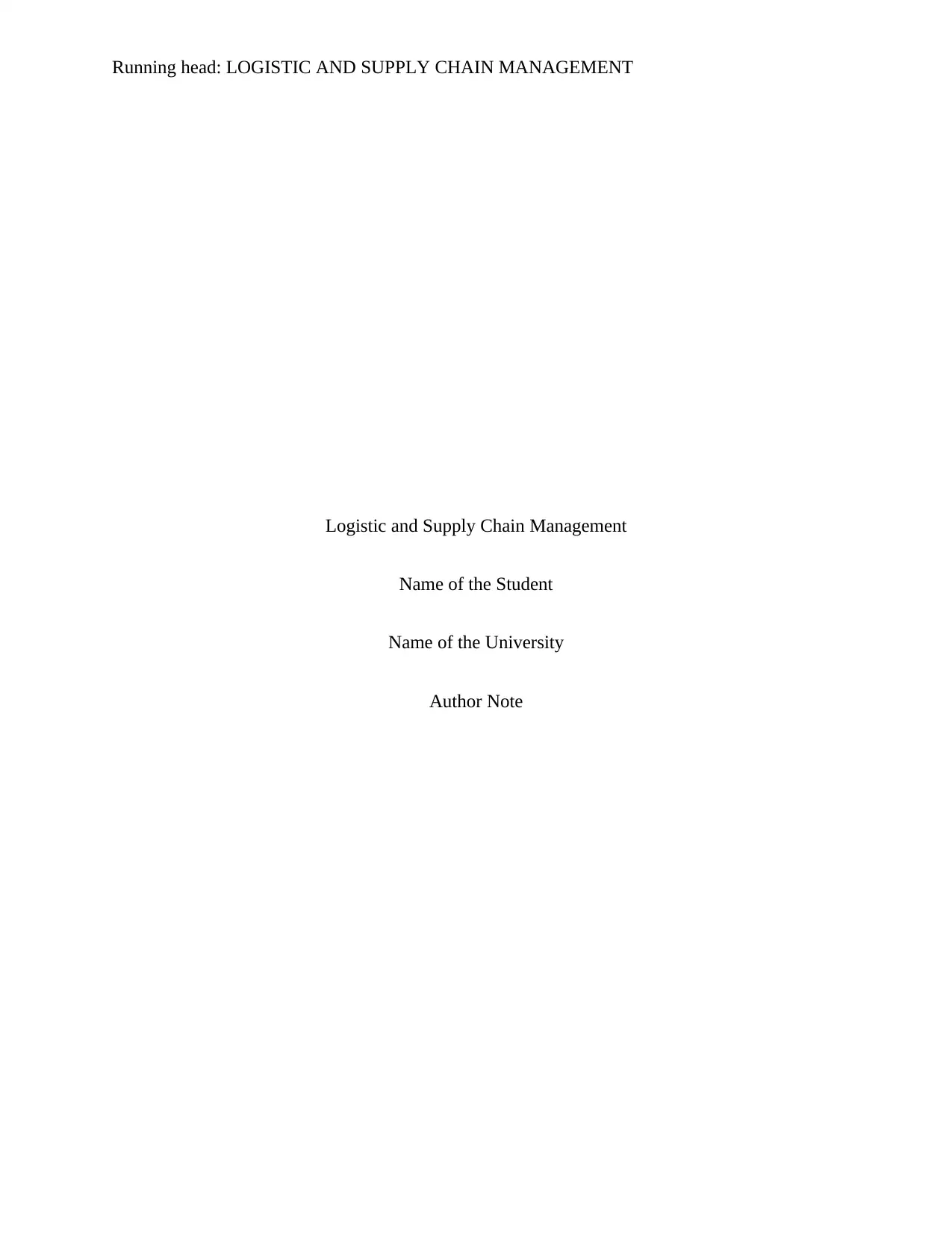
Running head: LOGISTIC AND SUPPLY CHAIN MANAGEMENT
Logistic and Supply Chain Management
Name of the Student
Name of the University
Author Note
Logistic and Supply Chain Management
Name of the Student
Name of the University
Author Note
Paraphrase This Document
Need a fresh take? Get an instant paraphrase of this document with our AI Paraphraser
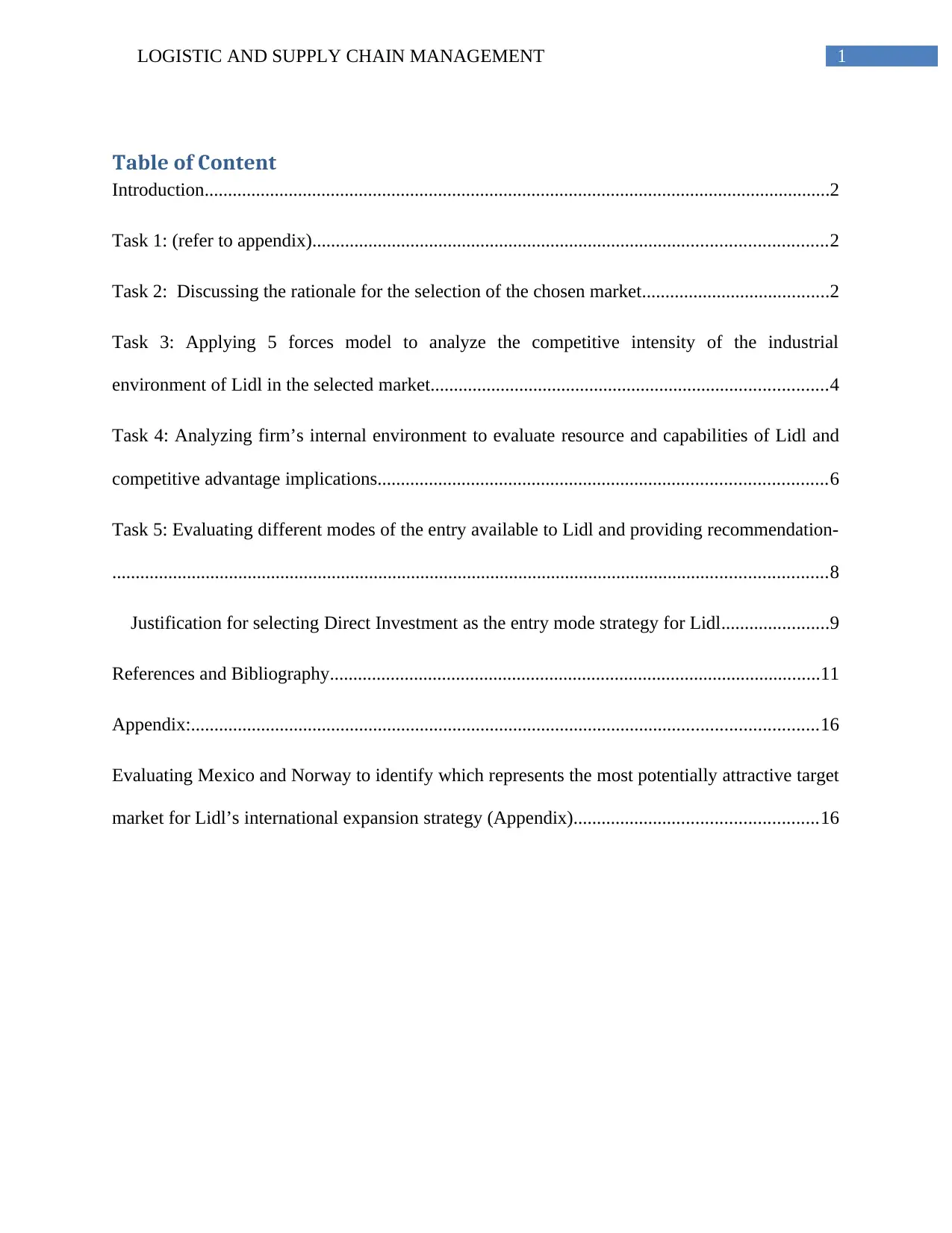
1LOGISTIC AND SUPPLY CHAIN MANAGEMENT
Table of Content
Introduction......................................................................................................................................2
Task 1: (refer to appendix)..............................................................................................................2
Task 2: Discussing the rationale for the selection of the chosen market........................................2
Task 3: Applying 5 forces model to analyze the competitive intensity of the industrial
environment of Lidl in the selected market.....................................................................................4
Task 4: Analyzing firm’s internal environment to evaluate resource and capabilities of Lidl and
competitive advantage implications................................................................................................6
Task 5: Evaluating different modes of the entry available to Lidl and providing recommendation-
.........................................................................................................................................................8
Justification for selecting Direct Investment as the entry mode strategy for Lidl.......................9
References and Bibliography.........................................................................................................11
Appendix:......................................................................................................................................16
Evaluating Mexico and Norway to identify which represents the most potentially attractive target
market for Lidl’s international expansion strategy (Appendix)....................................................16
Table of Content
Introduction......................................................................................................................................2
Task 1: (refer to appendix)..............................................................................................................2
Task 2: Discussing the rationale for the selection of the chosen market........................................2
Task 3: Applying 5 forces model to analyze the competitive intensity of the industrial
environment of Lidl in the selected market.....................................................................................4
Task 4: Analyzing firm’s internal environment to evaluate resource and capabilities of Lidl and
competitive advantage implications................................................................................................6
Task 5: Evaluating different modes of the entry available to Lidl and providing recommendation-
.........................................................................................................................................................8
Justification for selecting Direct Investment as the entry mode strategy for Lidl.......................9
References and Bibliography.........................................................................................................11
Appendix:......................................................................................................................................16
Evaluating Mexico and Norway to identify which represents the most potentially attractive target
market for Lidl’s international expansion strategy (Appendix)....................................................16
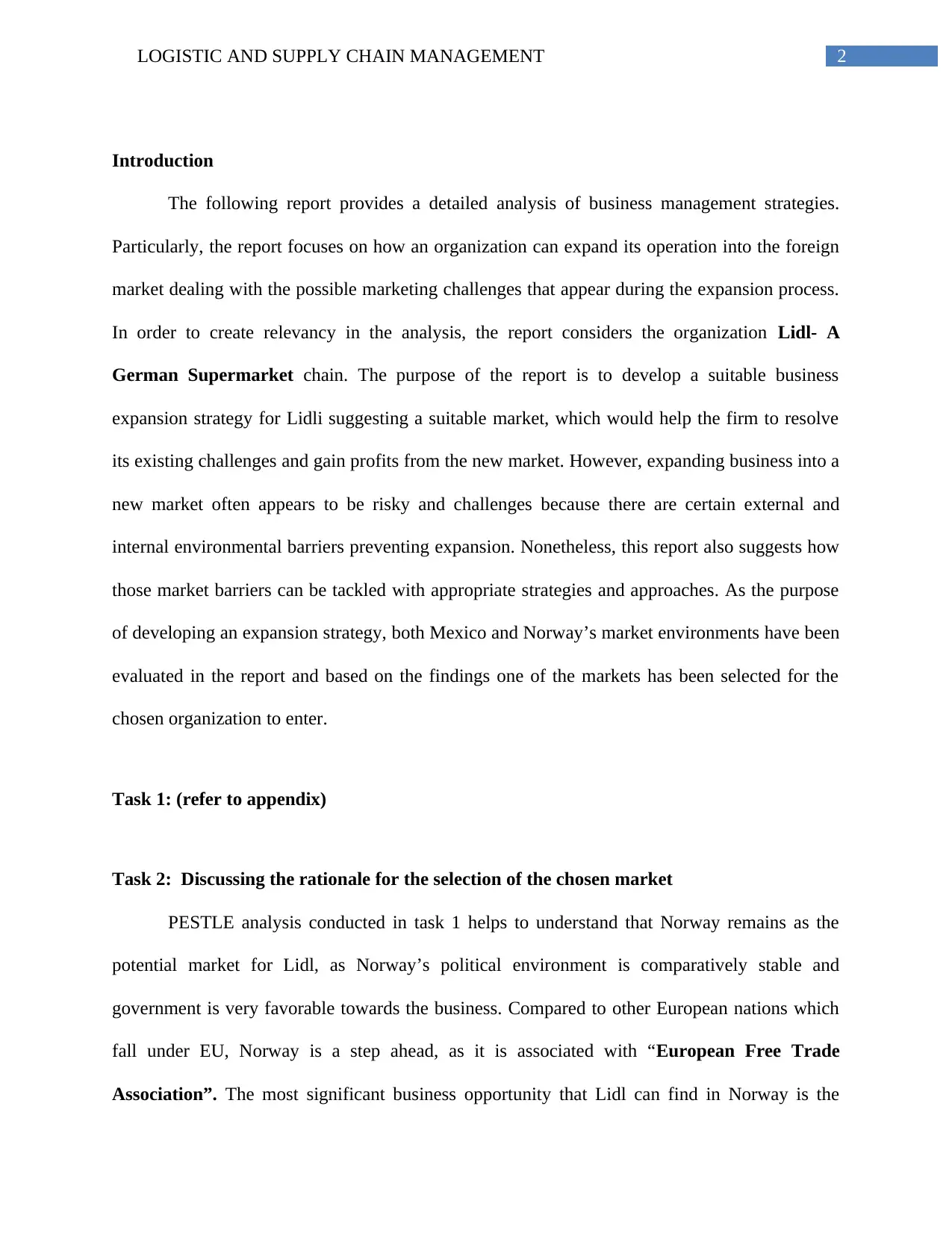
2LOGISTIC AND SUPPLY CHAIN MANAGEMENT
Introduction
The following report provides a detailed analysis of business management strategies.
Particularly, the report focuses on how an organization can expand its operation into the foreign
market dealing with the possible marketing challenges that appear during the expansion process.
In order to create relevancy in the analysis, the report considers the organization Lidl- A
German Supermarket chain. The purpose of the report is to develop a suitable business
expansion strategy for Lidli suggesting a suitable market, which would help the firm to resolve
its existing challenges and gain profits from the new market. However, expanding business into a
new market often appears to be risky and challenges because there are certain external and
internal environmental barriers preventing expansion. Nonetheless, this report also suggests how
those market barriers can be tackled with appropriate strategies and approaches. As the purpose
of developing an expansion strategy, both Mexico and Norway’s market environments have been
evaluated in the report and based on the findings one of the markets has been selected for the
chosen organization to enter.
Task 1: (refer to appendix)
Task 2: Discussing the rationale for the selection of the chosen market
PESTLE analysis conducted in task 1 helps to understand that Norway remains as the
potential market for Lidl, as Norway’s political environment is comparatively stable and
government is very favorable towards the business. Compared to other European nations which
fall under EU, Norway is a step ahead, as it is associated with “European Free Trade
Association”. The most significant business opportunity that Lidl can find in Norway is the
Introduction
The following report provides a detailed analysis of business management strategies.
Particularly, the report focuses on how an organization can expand its operation into the foreign
market dealing with the possible marketing challenges that appear during the expansion process.
In order to create relevancy in the analysis, the report considers the organization Lidl- A
German Supermarket chain. The purpose of the report is to develop a suitable business
expansion strategy for Lidli suggesting a suitable market, which would help the firm to resolve
its existing challenges and gain profits from the new market. However, expanding business into a
new market often appears to be risky and challenges because there are certain external and
internal environmental barriers preventing expansion. Nonetheless, this report also suggests how
those market barriers can be tackled with appropriate strategies and approaches. As the purpose
of developing an expansion strategy, both Mexico and Norway’s market environments have been
evaluated in the report and based on the findings one of the markets has been selected for the
chosen organization to enter.
Task 1: (refer to appendix)
Task 2: Discussing the rationale for the selection of the chosen market
PESTLE analysis conducted in task 1 helps to understand that Norway remains as the
potential market for Lidl, as Norway’s political environment is comparatively stable and
government is very favorable towards the business. Compared to other European nations which
fall under EU, Norway is a step ahead, as it is associated with “European Free Trade
Association”. The most significant business opportunity that Lidl can find in Norway is the
⊘ This is a preview!⊘
Do you want full access?
Subscribe today to unlock all pages.

Trusted by 1+ million students worldwide
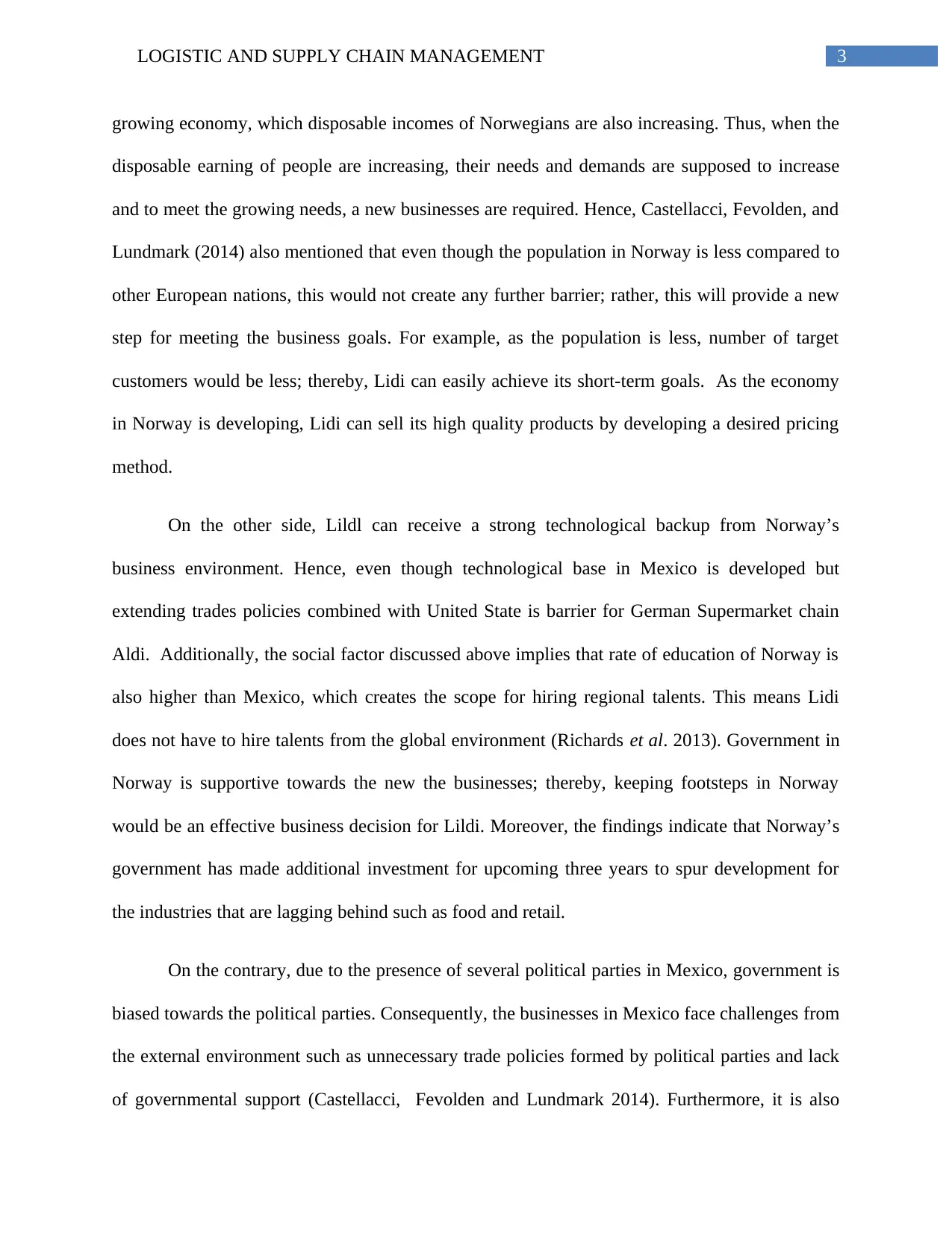
3LOGISTIC AND SUPPLY CHAIN MANAGEMENT
growing economy, which disposable incomes of Norwegians are also increasing. Thus, when the
disposable earning of people are increasing, their needs and demands are supposed to increase
and to meet the growing needs, a new businesses are required. Hence, Castellacci, Fevolden, and
Lundmark (2014) also mentioned that even though the population in Norway is less compared to
other European nations, this would not create any further barrier; rather, this will provide a new
step for meeting the business goals. For example, as the population is less, number of target
customers would be less; thereby, Lidi can easily achieve its short-term goals. As the economy
in Norway is developing, Lidi can sell its high quality products by developing a desired pricing
method.
On the other side, Lildl can receive a strong technological backup from Norway’s
business environment. Hence, even though technological base in Mexico is developed but
extending trades policies combined with United State is barrier for German Supermarket chain
Aldi. Additionally, the social factor discussed above implies that rate of education of Norway is
also higher than Mexico, which creates the scope for hiring regional talents. This means Lidi
does not have to hire talents from the global environment (Richards et al. 2013). Government in
Norway is supportive towards the new the businesses; thereby, keeping footsteps in Norway
would be an effective business decision for Lildi. Moreover, the findings indicate that Norway’s
government has made additional investment for upcoming three years to spur development for
the industries that are lagging behind such as food and retail.
On the contrary, due to the presence of several political parties in Mexico, government is
biased towards the political parties. Consequently, the businesses in Mexico face challenges from
the external environment such as unnecessary trade policies formed by political parties and lack
of governmental support (Castellacci, Fevolden and Lundmark 2014). Furthermore, it is also
growing economy, which disposable incomes of Norwegians are also increasing. Thus, when the
disposable earning of people are increasing, their needs and demands are supposed to increase
and to meet the growing needs, a new businesses are required. Hence, Castellacci, Fevolden, and
Lundmark (2014) also mentioned that even though the population in Norway is less compared to
other European nations, this would not create any further barrier; rather, this will provide a new
step for meeting the business goals. For example, as the population is less, number of target
customers would be less; thereby, Lidi can easily achieve its short-term goals. As the economy
in Norway is developing, Lidi can sell its high quality products by developing a desired pricing
method.
On the other side, Lildl can receive a strong technological backup from Norway’s
business environment. Hence, even though technological base in Mexico is developed but
extending trades policies combined with United State is barrier for German Supermarket chain
Aldi. Additionally, the social factor discussed above implies that rate of education of Norway is
also higher than Mexico, which creates the scope for hiring regional talents. This means Lidi
does not have to hire talents from the global environment (Richards et al. 2013). Government in
Norway is supportive towards the new the businesses; thereby, keeping footsteps in Norway
would be an effective business decision for Lildi. Moreover, the findings indicate that Norway’s
government has made additional investment for upcoming three years to spur development for
the industries that are lagging behind such as food and retail.
On the contrary, due to the presence of several political parties in Mexico, government is
biased towards the political parties. Consequently, the businesses in Mexico face challenges from
the external environment such as unnecessary trade policies formed by political parties and lack
of governmental support (Castellacci, Fevolden and Lundmark 2014). Furthermore, it is also
Paraphrase This Document
Need a fresh take? Get an instant paraphrase of this document with our AI Paraphraser
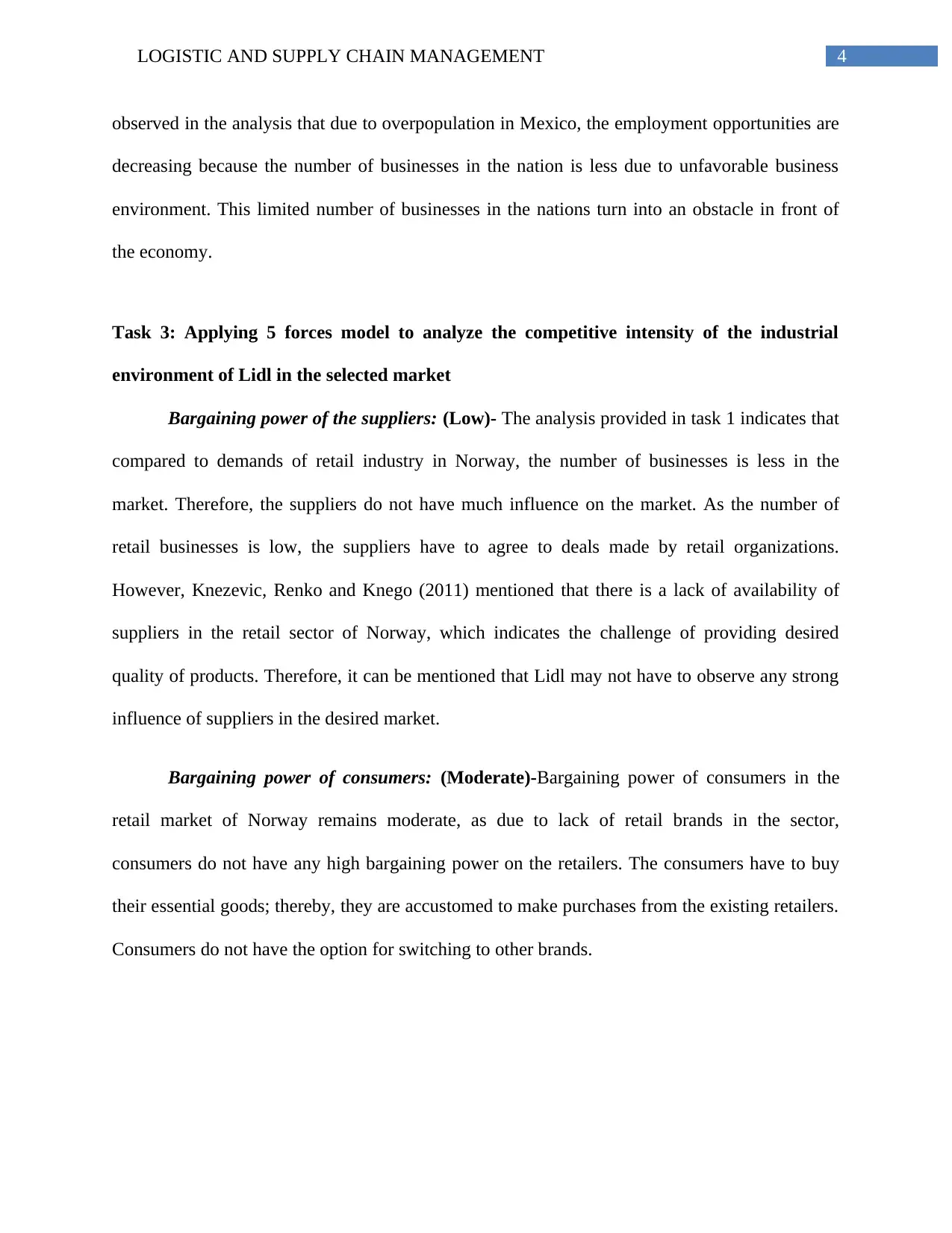
4LOGISTIC AND SUPPLY CHAIN MANAGEMENT
observed in the analysis that due to overpopulation in Mexico, the employment opportunities are
decreasing because the number of businesses in the nation is less due to unfavorable business
environment. This limited number of businesses in the nations turn into an obstacle in front of
the economy.
Task 3: Applying 5 forces model to analyze the competitive intensity of the industrial
environment of Lidl in the selected market
Bargaining power of the suppliers: (Low)- The analysis provided in task 1 indicates that
compared to demands of retail industry in Norway, the number of businesses is less in the
market. Therefore, the suppliers do not have much influence on the market. As the number of
retail businesses is low, the suppliers have to agree to deals made by retail organizations.
However, Knezevic, Renko and Knego (2011) mentioned that there is a lack of availability of
suppliers in the retail sector of Norway, which indicates the challenge of providing desired
quality of products. Therefore, it can be mentioned that Lidl may not have to observe any strong
influence of suppliers in the desired market.
Bargaining power of consumers: (Moderate)-Bargaining power of consumers in the
retail market of Norway remains moderate, as due to lack of retail brands in the sector,
consumers do not have any high bargaining power on the retailers. The consumers have to buy
their essential goods; thereby, they are accustomed to make purchases from the existing retailers.
Consumers do not have the option for switching to other brands.
observed in the analysis that due to overpopulation in Mexico, the employment opportunities are
decreasing because the number of businesses in the nation is less due to unfavorable business
environment. This limited number of businesses in the nations turn into an obstacle in front of
the economy.
Task 3: Applying 5 forces model to analyze the competitive intensity of the industrial
environment of Lidl in the selected market
Bargaining power of the suppliers: (Low)- The analysis provided in task 1 indicates that
compared to demands of retail industry in Norway, the number of businesses is less in the
market. Therefore, the suppliers do not have much influence on the market. As the number of
retail businesses is low, the suppliers have to agree to deals made by retail organizations.
However, Knezevic, Renko and Knego (2011) mentioned that there is a lack of availability of
suppliers in the retail sector of Norway, which indicates the challenge of providing desired
quality of products. Therefore, it can be mentioned that Lidl may not have to observe any strong
influence of suppliers in the desired market.
Bargaining power of consumers: (Moderate)-Bargaining power of consumers in the
retail market of Norway remains moderate, as due to lack of retail brands in the sector,
consumers do not have any high bargaining power on the retailers. The consumers have to buy
their essential goods; thereby, they are accustomed to make purchases from the existing retailers.
Consumers do not have the option for switching to other brands.

5LOGISTIC AND SUPPLY CHAIN MANAGEMENT
Figure 2: Porters’ five forces
(Source: Self-made)
Competitive rivalry: (High)- Competitive rivalry in the retail sector of Norway is high,
not because of the presence of competitors in the sector. Eistert (2013) particularly mentioned
that due to small market size, existing retail organizations in the sector have become competitive.
Kiwi, Meny and Narvesen acquire the entire market. Narvesen has the highest market share in
the retail sector. In addition, Swadley and Yücel (2011) mentioned that due to small market size,
competitors tend to apply aggressive business management strategies to excel over each other.
Threats of new entrants (High): Threats of new entrants is high, as the retail market of
Norway is favorable for new businesses. Customers’ demand is high and government is
approaching the foreign brands to establish business in Norway. In addition, the trade tax in
Norway, is comparatively less, which is a significant opportunity for the new businesses. As the
Figure 2: Porters’ five forces
(Source: Self-made)
Competitive rivalry: (High)- Competitive rivalry in the retail sector of Norway is high,
not because of the presence of competitors in the sector. Eistert (2013) particularly mentioned
that due to small market size, existing retail organizations in the sector have become competitive.
Kiwi, Meny and Narvesen acquire the entire market. Narvesen has the highest market share in
the retail sector. In addition, Swadley and Yücel (2011) mentioned that due to small market size,
competitors tend to apply aggressive business management strategies to excel over each other.
Threats of new entrants (High): Threats of new entrants is high, as the retail market of
Norway is favorable for new businesses. Customers’ demand is high and government is
approaching the foreign brands to establish business in Norway. In addition, the trade tax in
Norway, is comparatively less, which is a significant opportunity for the new businesses. As the
⊘ This is a preview!⊘
Do you want full access?
Subscribe today to unlock all pages.

Trusted by 1+ million students worldwide

6LOGISTIC AND SUPPLY CHAIN MANAGEMENT
economy is growing, the new businesses will observe a strong financial stability in businesses. In
this context, Reinartz et al. (2011) mentioned that as the purpose of business and urban
development, the government is backing up all new and medium size firms in the sector, which
indicates that new businesses will receive a positive support from the government.
Threats of substitutes: (High)- Threats of substitutes product is high in Norway; this
happens due to the absence of large organizations in the retail sector. In order to meet the
growing demand of retail products, several small businesses in the sector are growing in number
and they are approaching customers with substitute products.
Task 4: Analyzing firm’s internal environment to evaluate resource and capabilities of Lidl
and competitive advantage implications
Valuable- Lidl is one of the largest supermarket chains with respect to quality of
products and brand value. By performing operation in Germany, it is able to gain high brand
awareness in the global market. Machek (2012), Lidl is probably the only brand that has the
ability to gain profits by producing high quality products at the lowest price. Another significant
factor that makes the brand valuable is, exact selection of products in the store that customers
exactly look for. This practice certainly has a positive impact on sales because other
supermarkets tend to follow the traditional practices of storing extended categories of products
and most of which are not necessary to the customers (Kucharska et al. 2015). When a customer
enters the outlet of Lidl, they do not have to spend much time in selecting the products. All
Lidl’s stores are having the same intuitive layout, which makes it easier for the customer to find
what they need. In other supermarkets, customers buying decision is delayed due to the
confusion caused by mass categories of products, in which some are essential and some area not
economy is growing, the new businesses will observe a strong financial stability in businesses. In
this context, Reinartz et al. (2011) mentioned that as the purpose of business and urban
development, the government is backing up all new and medium size firms in the sector, which
indicates that new businesses will receive a positive support from the government.
Threats of substitutes: (High)- Threats of substitutes product is high in Norway; this
happens due to the absence of large organizations in the retail sector. In order to meet the
growing demand of retail products, several small businesses in the sector are growing in number
and they are approaching customers with substitute products.
Task 4: Analyzing firm’s internal environment to evaluate resource and capabilities of Lidl
and competitive advantage implications
Valuable- Lidl is one of the largest supermarket chains with respect to quality of
products and brand value. By performing operation in Germany, it is able to gain high brand
awareness in the global market. Machek (2012), Lidl is probably the only brand that has the
ability to gain profits by producing high quality products at the lowest price. Another significant
factor that makes the brand valuable is, exact selection of products in the store that customers
exactly look for. This practice certainly has a positive impact on sales because other
supermarkets tend to follow the traditional practices of storing extended categories of products
and most of which are not necessary to the customers (Kucharska et al. 2015). When a customer
enters the outlet of Lidl, they do not have to spend much time in selecting the products. All
Lidl’s stores are having the same intuitive layout, which makes it easier for the customer to find
what they need. In other supermarkets, customers buying decision is delayed due to the
confusion caused by mass categories of products, in which some are essential and some area not
Paraphrase This Document
Need a fresh take? Get an instant paraphrase of this document with our AI Paraphraser
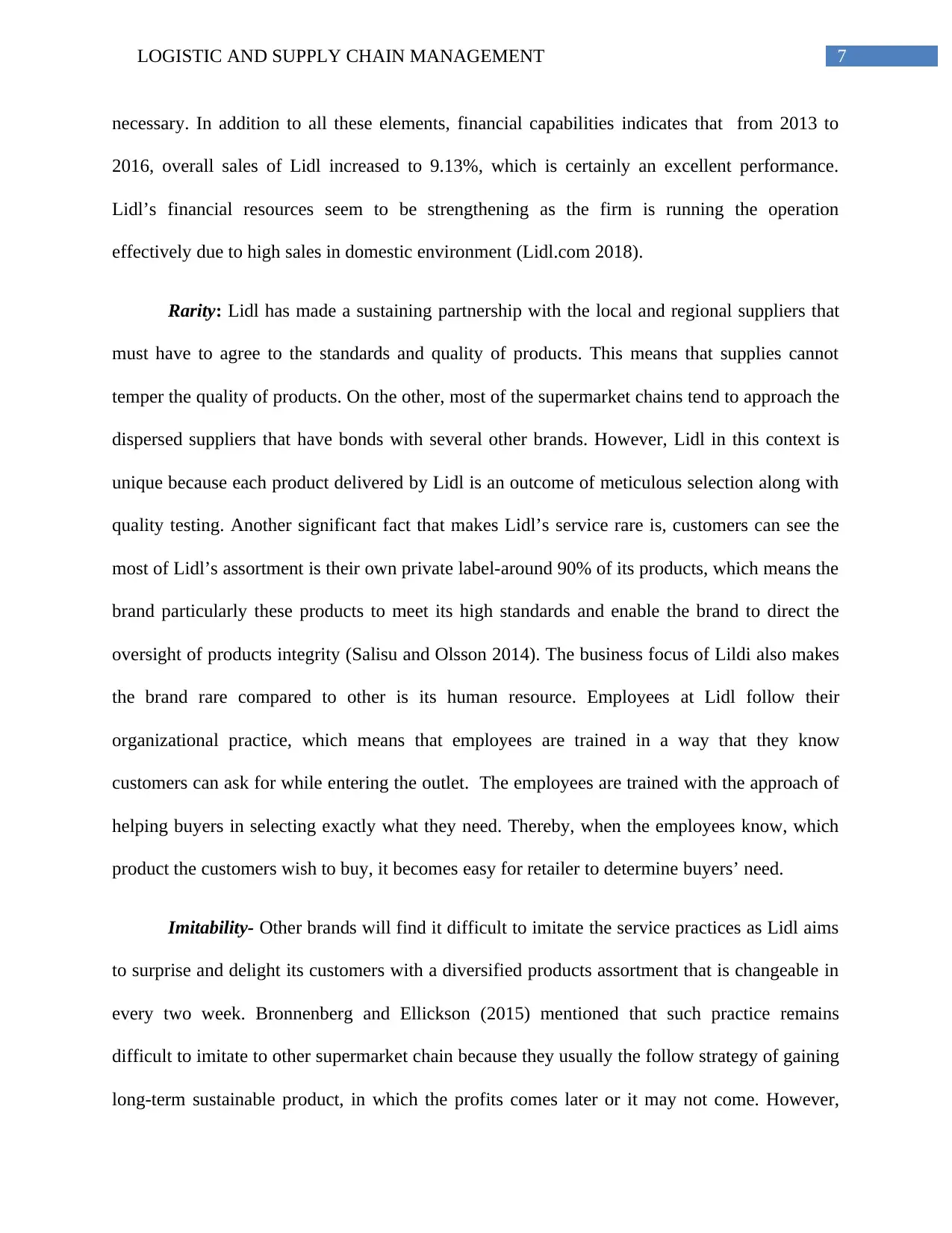
7LOGISTIC AND SUPPLY CHAIN MANAGEMENT
necessary. In addition to all these elements, financial capabilities indicates that from 2013 to
2016, overall sales of Lidl increased to 9.13%, which is certainly an excellent performance.
Lidl’s financial resources seem to be strengthening as the firm is running the operation
effectively due to high sales in domestic environment (Lidl.com 2018).
Rarity: Lidl has made a sustaining partnership with the local and regional suppliers that
must have to agree to the standards and quality of products. This means that supplies cannot
temper the quality of products. On the other, most of the supermarket chains tend to approach the
dispersed suppliers that have bonds with several other brands. However, Lidl in this context is
unique because each product delivered by Lidl is an outcome of meticulous selection along with
quality testing. Another significant fact that makes Lidl’s service rare is, customers can see the
most of Lidl’s assortment is their own private label-around 90% of its products, which means the
brand particularly these products to meet its high standards and enable the brand to direct the
oversight of products integrity (Salisu and Olsson 2014). The business focus of Lildi also makes
the brand rare compared to other is its human resource. Employees at Lidl follow their
organizational practice, which means that employees are trained in a way that they know
customers can ask for while entering the outlet. The employees are trained with the approach of
helping buyers in selecting exactly what they need. Thereby, when the employees know, which
product the customers wish to buy, it becomes easy for retailer to determine buyers’ need.
Imitability- Other brands will find it difficult to imitate the service practices as Lidl aims
to surprise and delight its customers with a diversified products assortment that is changeable in
every two week. Bronnenberg and Ellickson (2015) mentioned that such practice remains
difficult to imitate to other supermarket chain because they usually the follow strategy of gaining
long-term sustainable product, in which the profits comes later or it may not come. However,
necessary. In addition to all these elements, financial capabilities indicates that from 2013 to
2016, overall sales of Lidl increased to 9.13%, which is certainly an excellent performance.
Lidl’s financial resources seem to be strengthening as the firm is running the operation
effectively due to high sales in domestic environment (Lidl.com 2018).
Rarity: Lidl has made a sustaining partnership with the local and regional suppliers that
must have to agree to the standards and quality of products. This means that supplies cannot
temper the quality of products. On the other, most of the supermarket chains tend to approach the
dispersed suppliers that have bonds with several other brands. However, Lidl in this context is
unique because each product delivered by Lidl is an outcome of meticulous selection along with
quality testing. Another significant fact that makes Lidl’s service rare is, customers can see the
most of Lidl’s assortment is their own private label-around 90% of its products, which means the
brand particularly these products to meet its high standards and enable the brand to direct the
oversight of products integrity (Salisu and Olsson 2014). The business focus of Lildi also makes
the brand rare compared to other is its human resource. Employees at Lidl follow their
organizational practice, which means that employees are trained in a way that they know
customers can ask for while entering the outlet. The employees are trained with the approach of
helping buyers in selecting exactly what they need. Thereby, when the employees know, which
product the customers wish to buy, it becomes easy for retailer to determine buyers’ need.
Imitability- Other brands will find it difficult to imitate the service practices as Lidl aims
to surprise and delight its customers with a diversified products assortment that is changeable in
every two week. Bronnenberg and Ellickson (2015) mentioned that such practice remains
difficult to imitate to other supermarket chain because they usually the follow strategy of gaining
long-term sustainable product, in which the profits comes later or it may not come. However,
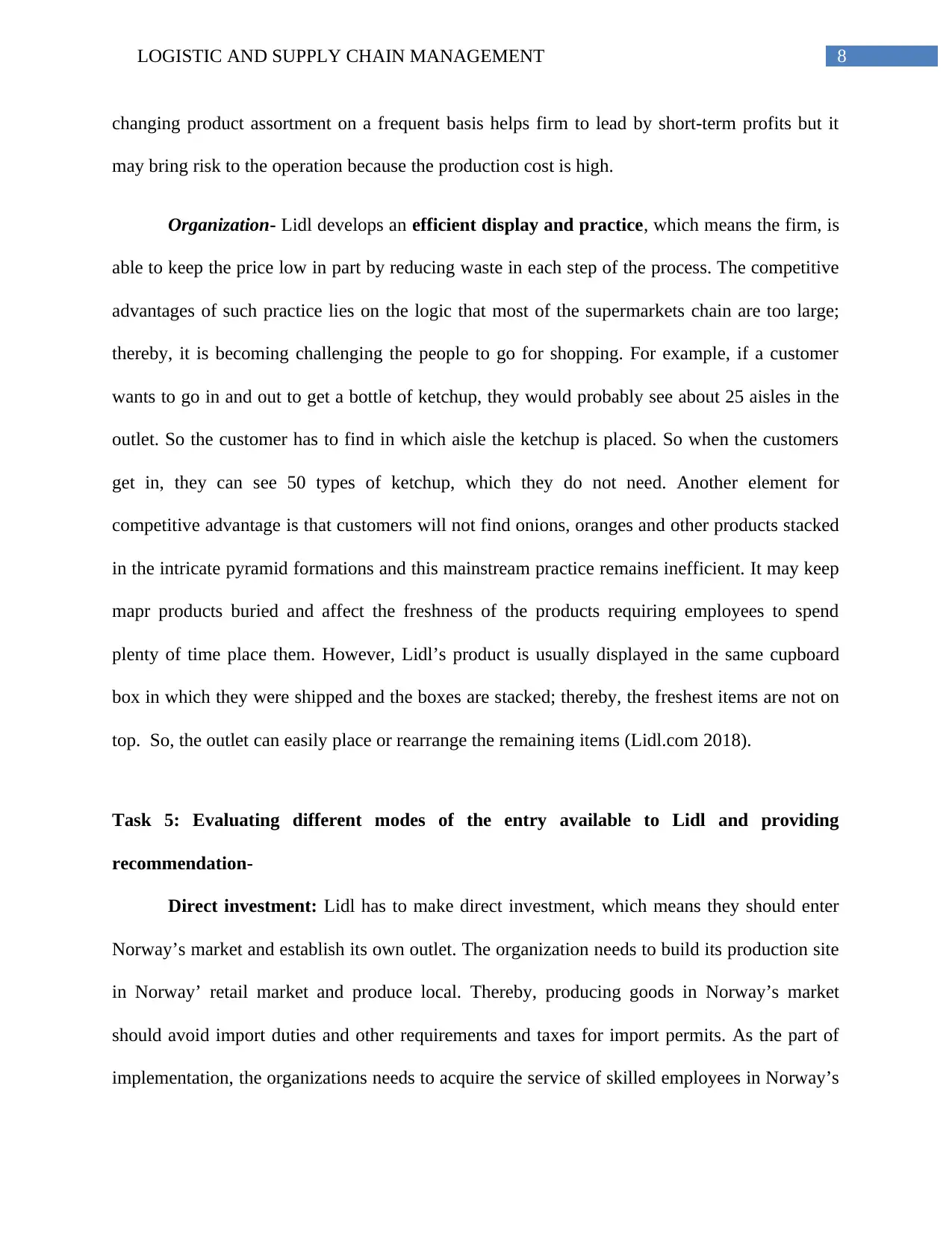
8LOGISTIC AND SUPPLY CHAIN MANAGEMENT
changing product assortment on a frequent basis helps firm to lead by short-term profits but it
may bring risk to the operation because the production cost is high.
Organization- Lidl develops an efficient display and practice, which means the firm, is
able to keep the price low in part by reducing waste in each step of the process. The competitive
advantages of such practice lies on the logic that most of the supermarkets chain are too large;
thereby, it is becoming challenging the people to go for shopping. For example, if a customer
wants to go in and out to get a bottle of ketchup, they would probably see about 25 aisles in the
outlet. So the customer has to find in which aisle the ketchup is placed. So when the customers
get in, they can see 50 types of ketchup, which they do not need. Another element for
competitive advantage is that customers will not find onions, oranges and other products stacked
in the intricate pyramid formations and this mainstream practice remains inefficient. It may keep
mapr products buried and affect the freshness of the products requiring employees to spend
plenty of time place them. However, Lidl’s product is usually displayed in the same cupboard
box in which they were shipped and the boxes are stacked; thereby, the freshest items are not on
top. So, the outlet can easily place or rearrange the remaining items (Lidl.com 2018).
Task 5: Evaluating different modes of the entry available to Lidl and providing
recommendation-
Direct investment: Lidl has to make direct investment, which means they should enter
Norway’s market and establish its own outlet. The organization needs to build its production site
in Norway’ retail market and produce local. Thereby, producing goods in Norway’s market
should avoid import duties and other requirements and taxes for import permits. As the part of
implementation, the organizations needs to acquire the service of skilled employees in Norway’s
changing product assortment on a frequent basis helps firm to lead by short-term profits but it
may bring risk to the operation because the production cost is high.
Organization- Lidl develops an efficient display and practice, which means the firm, is
able to keep the price low in part by reducing waste in each step of the process. The competitive
advantages of such practice lies on the logic that most of the supermarkets chain are too large;
thereby, it is becoming challenging the people to go for shopping. For example, if a customer
wants to go in and out to get a bottle of ketchup, they would probably see about 25 aisles in the
outlet. So the customer has to find in which aisle the ketchup is placed. So when the customers
get in, they can see 50 types of ketchup, which they do not need. Another element for
competitive advantage is that customers will not find onions, oranges and other products stacked
in the intricate pyramid formations and this mainstream practice remains inefficient. It may keep
mapr products buried and affect the freshness of the products requiring employees to spend
plenty of time place them. However, Lidl’s product is usually displayed in the same cupboard
box in which they were shipped and the boxes are stacked; thereby, the freshest items are not on
top. So, the outlet can easily place or rearrange the remaining items (Lidl.com 2018).
Task 5: Evaluating different modes of the entry available to Lidl and providing
recommendation-
Direct investment: Lidl has to make direct investment, which means they should enter
Norway’s market and establish its own outlet. The organization needs to build its production site
in Norway’ retail market and produce local. Thereby, producing goods in Norway’s market
should avoid import duties and other requirements and taxes for import permits. As the part of
implementation, the organizations needs to acquire the service of skilled employees in Norway’s
⊘ This is a preview!⊘
Do you want full access?
Subscribe today to unlock all pages.

Trusted by 1+ million students worldwide

9LOGISTIC AND SUPPLY CHAIN MANAGEMENT
market as well as acquire intelligence already held by the people in the market. Lidi can gain
advantages of lower cost because it will hire regional employees- cheaper labor. As Lidl wants to
cut the cost of operation as their strategy of gaining competitive advantages, hiring regional
employees from Norway’s market is an effective choice. Hence, Boeh and Beamish (2012) also
mentioned that whatever the cause for making direct investment decision, it has to be related
with the context of what the company wants to gain or achieve strategically.
Exporting: As put forward by Ahsan and Musteen (2011) exporting could permit small
businesses to acquire their current model as well as product. This method helps to send goods in
another nation’s market for distribution. Exporting does not have high risk, which may cause by
implication. However, if Lidl applies this exporting strategy, it might have to face the barrier of
exporting heavy supply of goods. However, exporting goods into a new market may allow Lidl
to determine how effectively items can be sold as well as it can have a full control over the
adjustment.
Justification for selecting Direct Investment as the entry mode strategy for Lidl
As Lidl is a supermarket chain, it has to build a physical presence in the selected market.
It cannot send its supplies of products in the chosen market via third party vendors. A retail
organization always needs to create its own presence in the market to gain customers’ trust.
Customers do not prefer to buy essential commodities from a band that does not have physical
presence. In addition, there is an old cliché that supermarket increase their brand awareness by
developing a sophisticated and environmentally friendly outlet that attracts’ customer attention.
Moreover, the analysis in Task 1 indicates that Norway’ government is welcoming the foreign
direct investment as their purpose of urban development. This means if Lidl enters Norway’s
market through direct investment, it may receive government’s backup. Moreover, the PESTLE
market as well as acquire intelligence already held by the people in the market. Lidi can gain
advantages of lower cost because it will hire regional employees- cheaper labor. As Lidl wants to
cut the cost of operation as their strategy of gaining competitive advantages, hiring regional
employees from Norway’s market is an effective choice. Hence, Boeh and Beamish (2012) also
mentioned that whatever the cause for making direct investment decision, it has to be related
with the context of what the company wants to gain or achieve strategically.
Exporting: As put forward by Ahsan and Musteen (2011) exporting could permit small
businesses to acquire their current model as well as product. This method helps to send goods in
another nation’s market for distribution. Exporting does not have high risk, which may cause by
implication. However, if Lidl applies this exporting strategy, it might have to face the barrier of
exporting heavy supply of goods. However, exporting goods into a new market may allow Lidl
to determine how effectively items can be sold as well as it can have a full control over the
adjustment.
Justification for selecting Direct Investment as the entry mode strategy for Lidl
As Lidl is a supermarket chain, it has to build a physical presence in the selected market.
It cannot send its supplies of products in the chosen market via third party vendors. A retail
organization always needs to create its own presence in the market to gain customers’ trust.
Customers do not prefer to buy essential commodities from a band that does not have physical
presence. In addition, there is an old cliché that supermarket increase their brand awareness by
developing a sophisticated and environmentally friendly outlet that attracts’ customer attention.
Moreover, the analysis in Task 1 indicates that Norway’ government is welcoming the foreign
direct investment as their purpose of urban development. This means if Lidl enters Norway’s
market through direct investment, it may receive government’s backup. Moreover, the PESTLE
Paraphrase This Document
Need a fresh take? Get an instant paraphrase of this document with our AI Paraphraser

10LOGISTIC AND SUPPLY CHAIN MANAGEMENT
analysis indicates that political environment in Norway is stable, which means while establishing
the outlet, the firm does not have to face any political or unions’ barriers.
On the other side, other mode of entry such as franchising is not suitable here because if
a third part vendor runs Lidl’s operation in Norway, Lidi does not have any control on its
operation and the organization will not know how the market responses. On the other side, Lidl
will not also be able to achieve its goals of acquiring competitive advantages as because in
franchising, the firm does not have track of labor hired and their costs. Moreover, the
government in Norway can limit or prohibit the imports of goods from Lidl’s domestic market,
but Lidl develop its own production site in Norway’ market, it does not have to face any such
barriers.
analysis indicates that political environment in Norway is stable, which means while establishing
the outlet, the firm does not have to face any political or unions’ barriers.
On the other side, other mode of entry such as franchising is not suitable here because if
a third part vendor runs Lidl’s operation in Norway, Lidi does not have any control on its
operation and the organization will not know how the market responses. On the other side, Lidl
will not also be able to achieve its goals of acquiring competitive advantages as because in
franchising, the firm does not have track of labor hired and their costs. Moreover, the
government in Norway can limit or prohibit the imports of goods from Lidl’s domestic market,
but Lidl develop its own production site in Norway’ market, it does not have to face any such
barriers.

11LOGISTIC AND SUPPLY CHAIN MANAGEMENT
References and Bibliography
Ahsan, M. and Musteen, M., 2011. Multinational enterprises' entry mode strategies and
uncertainty: A review and extension. International Journal of Management Reviews, 13(4),
pp.376-392.
Angelsen, A., 2013. REDD+ as performance-based aid: general lessons and bilateral
agreements of Norway (No. 2013/135). WIDER Working Paper.
Armenta, Á., Serrano, A., Cabrera, M. and Conte, R., 2012. The new digital divide: the
confluence of broadband penetration, sustainable development, technology adoption and
community participation. Information Technology for Development, 18(4), pp.345-353.
Boeh, K.K. and Beamish, P.W., 2012. Travel time and the liability of distance in foreign direct
investment: Location choice and entry mode. Journal of International Business Studies, 43(5),
pp.525-535.
Bronnenberg, B.J. and Ellickson, P.B., 2015. Adolescence and the path to maturity in global
retail. Journal of Economic Perspectives, 29(4), pp.113-34.
Castellacci, F., Fevolden, A.M. and Lundmark, M., 2014. How are defence companies
responding to EU defence and security market liberalization? A comparative study of Norway
and Sweden. Journal of European public policy, 21(8), pp.1218-1235.
Cimoli, M., 2013. Developing Innovation Systems: Mexico in a global context. Routledge.
Dobado, R. and Marrero, G.A., 2011. The role of the Spanish imperial state in the mining ‐led
growth of Bourbon Mexico's economy. The Economic History Review, 64(3), pp.855-884.
References and Bibliography
Ahsan, M. and Musteen, M., 2011. Multinational enterprises' entry mode strategies and
uncertainty: A review and extension. International Journal of Management Reviews, 13(4),
pp.376-392.
Angelsen, A., 2013. REDD+ as performance-based aid: general lessons and bilateral
agreements of Norway (No. 2013/135). WIDER Working Paper.
Armenta, Á., Serrano, A., Cabrera, M. and Conte, R., 2012. The new digital divide: the
confluence of broadband penetration, sustainable development, technology adoption and
community participation. Information Technology for Development, 18(4), pp.345-353.
Boeh, K.K. and Beamish, P.W., 2012. Travel time and the liability of distance in foreign direct
investment: Location choice and entry mode. Journal of International Business Studies, 43(5),
pp.525-535.
Bronnenberg, B.J. and Ellickson, P.B., 2015. Adolescence and the path to maturity in global
retail. Journal of Economic Perspectives, 29(4), pp.113-34.
Castellacci, F., Fevolden, A.M. and Lundmark, M., 2014. How are defence companies
responding to EU defence and security market liberalization? A comparative study of Norway
and Sweden. Journal of European public policy, 21(8), pp.1218-1235.
Cimoli, M., 2013. Developing Innovation Systems: Mexico in a global context. Routledge.
Dobado, R. and Marrero, G.A., 2011. The role of the Spanish imperial state in the mining ‐led
growth of Bourbon Mexico's economy. The Economic History Review, 64(3), pp.855-884.
⊘ This is a preview!⊘
Do you want full access?
Subscribe today to unlock all pages.

Trusted by 1+ million students worldwide
1 out of 20
Related Documents
Your All-in-One AI-Powered Toolkit for Academic Success.
+13062052269
info@desklib.com
Available 24*7 on WhatsApp / Email
![[object Object]](/_next/static/media/star-bottom.7253800d.svg)
Unlock your academic potential
Copyright © 2020–2025 A2Z Services. All Rights Reserved. Developed and managed by ZUCOL.





